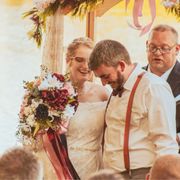Jonah H.
Yelp
Today, I went to Colonial Williamsburg. I grew up in Williamsburg. I've been to Colonial Williamsburg more times than I can count. CW (as the locals call it) is a beautiful place to walk around with friends, visit the Cheese Shop or Aroma's, and maybe play Pokemon GO. Outside of the annual elementary school field trip, I had never visited inside the buildings or spoke to the artisans and merchants. Those are traditionally paid experiences, and a local like myself already knew everything there was to know about the colonial past.
Today, I went to Colonial Williamsburg with a paid ticket in hand, a new experience. My mother (who's lived in Williamsburg decades longer than myself) and I walked through the city in a fresh way. First, we stopped at the cabinetmakers'. I've stood outside that building dozens of times. It is a quaint cottage over a small stream, perfect for photos and rest. I've never been inside before. Three artisans were caving wooden legs, carving designs, and planing lumber. When we entered, one stopped to greet us and explain their work. He spoke about colonial woodworking, CW's records of this shop, and the nature of being a cabinetmaker. There was also a record of a harpsichord being sold at the shop in the colonial era, so the modern artisans also learned to craft and repair the instrument. It was beyond impressive.
Next, we went to a lumberyard where two other artisans were working. One explained the work of constructing colonial buildings. Each new building was constructed in the lumberyard, disassembled, and then transported (mostly by oxen) to its final destination to be rebuilt. The artisan also showed us the original foundation of a colonial building right under our feet. She explained how CW could study and infer information from a building's foundation. A thicker foundation housed a two or three-story building. Wear in a specific area might show where a door was. Sometimes items were even found under the foundation, like a barrel beneath the Bray School.
We then walked over to the colonial farm, marked by a large windmill held up above the ground by posts. The farmer was my favorite tradesman. He explained how the farming habits of the colonists differed before and during the Revolutionary War. He had us separate cotton seeds by hand as he told us about everything from tobacco to linens. In the colonial era, when times were good, people could afford to buy clothing made from flax, soft, durable, and often dyed. When tobacco wasn't selling well, like during the war, farmers had to grow cotton to make their clothes. We also learned more about the role of enslaved people in the colonial capital.
We met two individuals, historians maybe, outside the Bray School. The Bray School was a school for free and enslaved black children in colonial Williamsburg. CW has been working with William and Mary to discover more about the school and its students, but in its time it taught a couple hundred kids, mostly enslaved. The school was free, and one of its primary purposes was to teach the children to read the Bible. It also taught the children "their place," making sure to teach all the scriptures permitting slavery. We got to see the copies of primary sources, but the school was still being reconstructed, so we couldn't go inside.
We stopped at Merchants Square for lunch. (I recommend the prosciutto, provolone & roasted tomato sandwich at the Cheese Shop and a hot chocolate from Kilwins.) Our last stop at CW was the courthouse. A mock trial was being held and I was appointed the bailiff and had a speaking role! A court of 11 volunteer jurors heard three real colonial cases (more volunteers from the crowd). The court clerk spoke between the cases, explaining the colonial law and how it applied. It was super interesting to hear actual cases brought up by men and women hundreds of years ago.
Overall, I really enjoyed the experience. As someone who has grown up a few miles from the historic sight, I can honestly say this trip was a wholly unique experience. I recommend Colonial Williamsburg not just to tourists but to locals as well. Colonial Williamsburg has dozens of different historic trades, shows, and demonstrations, and we only got to see a few. I will definitely be going back to see more.











































